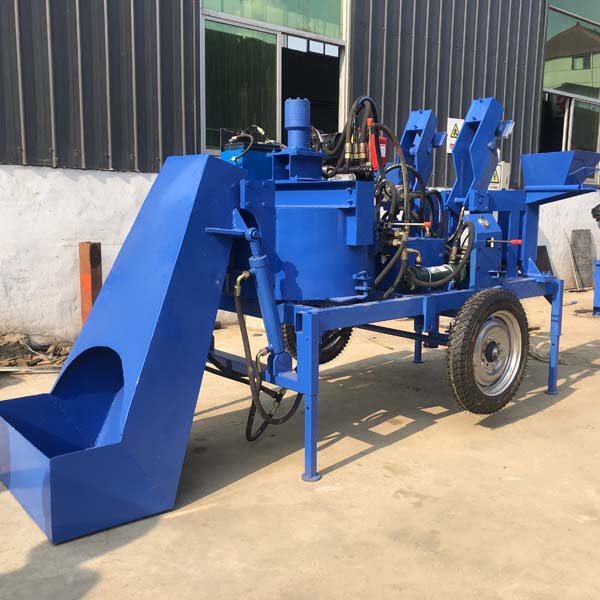
Image source Aiweibrickmachine
Title: Exploring Business Models for Semi-Automatic Block Production Lines
Introduction
In an age of rapid urbanization and construction, the demand for building materials, particularly concrete blocks, remains consistently high. Semi-automatic block production lines have emerged as a crucial component of the construction industry, streamlining the manufacturing process of these essential building blocks. This article delves into the various business models available for entrepreneurs looking to invest in semi-automatic block production lines, providing insights into the opportunities, challenges, and profitability of this industry.
The Growing Demand for Concrete Blocks
Concrete blocks, also known as concrete masonry units (CMUs), are a fundamental construction material. They are used in the construction of residential buildings, commercial structures, infrastructure projects, and more. The key reasons behind the continuous demand for concrete blocks are their durability, strength, cost-effectiveness, and versatility in construction. As urban populations expand and infrastructure development projects increase, the demand for concrete blocks is expected to rise.
Semi-Automatic Block Production Lines: An Overview
Semi-automatic block production lines have revolutionized the manufacturing of concrete blocks. These production lines typically involve a combination of automated and manual processes to produce high-quality blocks efficiently. They consist of machines like concrete mixers, block making machines, curing chambers, and handling equipment.
The semi-automatic aspect means that some tasks, such as feeding raw materials into machines, removing finished blocks, and quality control, require human intervention. This combination of automation and manual labor provides a cost-effective solution for producing concrete blocks and allows for greater flexibility in production volumes and block designs.
Business Models for Semi-Automatic Block Production Lines
When considering investment in a semi-automatic block production line, entrepreneurs have several business models to choose from, each with its unique advantages and challenges.
1. Manufacturing and Sales
One of the most common business models involves setting up a production facility, manufacturing concrete blocks, and selling them to construction companies, contractors, and retailers. This model is a straightforward way to enter the market and offers consistent revenue streams.
Pros:
– Steady demand for concrete blocks.
– Potential for scale-up and growth.
– Diversification through offering various block sizes and designs.
– Building strong relationships with construction industry clients.
Cons:
– Initial setup costs can be substantial.
– Competition in the market may be fierce.
– Seasonal demand fluctuations could impact cash flow.
2. Custom Block Production
Some entrepreneurs opt to focus on niche markets by offering customized concrete blocks. These blocks may have unique designs, sizes, or finishes tailored to specific customer requirements. This approach demands innovation and strong marketing to identify profitable niches.
Pros:
– Higher profit margins due to specialization.
– Limited competition in specialized segments.
– Strong branding and marketing can attract premium clients.
– Opportunity to build long-term customer relationships.
Cons:
– Requires investment in research and development.
– Marketing and advertising costs can be significant.
– Smaller customer base, making market fluctuations riskier.
3. Block Rental and Leasing
Another innovative approach is to offer concrete block rental or leasing services. This model is attractive to construction companies and contractors who may not want to invest in block production equipment, as it offers cost-effective and flexible solutions.
Pros:
– Recurring revenue through leasing contracts.
– Reduced competition in this niche market.
– Opportunity for long-term contracts and partnerships.
– Can diversify with related services like transportation and maintenance.
Cons:
– Initial investment in a fleet of production machines.
– Need to establish a network of clients and contracts.
– Market research is essential to identify regions with rental demand.
4. Franchise and Licensing
Entrepreneurs who want to enter the semi-automatic block production industry with reduced risk can consider franchising or licensing models. They can purchase an established brand’s rights, equipment, and know-how to start their own production line.
Pros:
– Reduced risk with an established brand and business model.
– Access to proven operational processes and marketing strategies.
– Support from the parent company in terms of training and resources.
– Easier access to financing and partnerships.
Cons:
– Costs associated with franchise or licensing fees.
– Limited autonomy in business decision-making.
– Potential competition with other franchisees of the same brand.
Challenges and Considerations
While the business models for semi-automatic block production lines offer various opportunities, it’s crucial to consider the challenges involved:
1. Market Research: Conduct comprehensive market research to identify local demand, competition, and potential niches. Understanding your target market is critical to success.
2. Investment: The initial capital required for setting up a production line, buying equipment, and acquiring raw materials can be substantial. Secure adequate funding or financing.
3. Quality Control: Maintaining high-quality standards is essential in this industry. Implement quality control measures to ensure the durability and strength of your concrete blocks.
4. Compliance and Regulations: Be aware of local and national regulations related to building materials, safety, and environmental standards. Compliance is crucial to avoid legal issues.
5. Human Resources: Recruiting and retaining skilled staff for operating and maintaining production equipment is essential. Training is often required.
6. Marketing and Branding: Effective marketing and branding strategies are key to success, whether you’re selling standard blocks or offering custom solutions. Building a strong brand can set you apart from competitors.
7. Risk Management: Prepare for unexpected market fluctuations, supply chain disruptions, and other risks that may affect your business.
Conclusion
Investing in a semi-automatic block production line is a promising venture in the construction industry, driven by the ongoing demand for concrete blocks. The choice of a business model will depend on your resources, goals, and market research. Whether you decide to focus on manufacturing and sales, customized blocks, rental and leasing services, or franchising, success in this industry will depend on factors like quality control, marketing, and adapting to market changes. With the right approach and dedication, entrepreneurs can find profitable opportunities in the world of semi-automatic block production lines.
